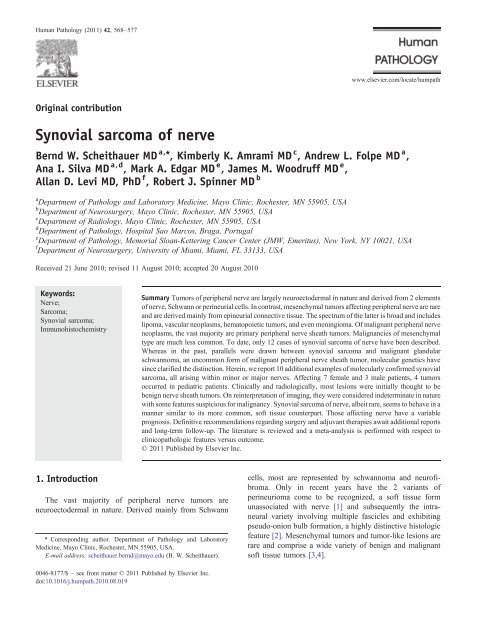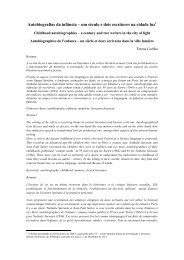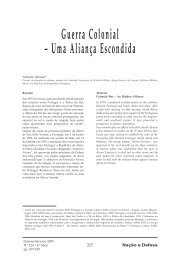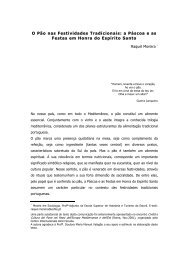Synovial sarcoma of nerve.pdf
Synovial sarcoma of nerve.pdf
Synovial sarcoma of nerve.pdf
Create successful ePaper yourself
Turn your PDF publications into a flip-book with our unique Google optimized e-Paper software.
Human Pathology (2011) 42, 568–577<br />
Original contribution<br />
<strong>Synovial</strong> <strong>sarcoma</strong> <strong>of</strong> <strong>nerve</strong><br />
Bernd W. Scheithauer MD a,⁎ , Kimberly K. Amrami MD c , Andrew L. Folpe MD a ,<br />
Ana I. Silva MD a,d , Mark A. Edgar MD e , James M. Woodruff MD e ,<br />
Allan D. Levi MD, PhD f , Robert J. Spinner MD b<br />
a Department <strong>of</strong> Pathology and Laboratory Medicine, Mayo Clinic, Rochester, MN 55905, USA<br />
b Department <strong>of</strong> Neurosurgery, Mayo Clinic, Rochester, MN 55905, USA<br />
c Department <strong>of</strong> Radiology, Mayo Clinic, Rochester, MN 55905, USA<br />
d Department <strong>of</strong> Pathology, Hospital Sao Marcos, Braga, Portugal<br />
e Department <strong>of</strong> Pathology, Memorial Sloan-Kettering Cancer Center (JMW, Emeritus), New York, NY 10021, USA<br />
f Department <strong>of</strong> Neurosurgery, University <strong>of</strong> Miami, Miami, FL 33133, USA<br />
Received 21 June 2010; revised 11 August 2010; accepted 20 August 2010<br />
Keywords:<br />
Nerve;<br />
Sarcoma;<br />
<strong>Synovial</strong> <strong>sarcoma</strong>;<br />
Immunohistochemistry<br />
1. Introduction<br />
The vast majority <strong>of</strong> peripheral <strong>nerve</strong> tumors are<br />
neuroectodermal in nature. Derived mainly from Schwann<br />
⁎ Corresponding author. Department <strong>of</strong> Pathology and Laboratory<br />
Medicine, Mayo Clinic, Rochester, MN 55905, USA.<br />
E-mail address: scheithauer.bernd@mayo.edu (B. W. Scheithauer).<br />
0046-8177/$ – see front matter © 2011 Published by Elsevier Inc.<br />
doi:10.1016/j.humpath.2010.08.019<br />
www.elsevier.com/locate/humpath<br />
Summary Tumors <strong>of</strong> peripheral <strong>nerve</strong> are largely neuroectodermal in nature and derived from 2 elements<br />
<strong>of</strong> <strong>nerve</strong>, Schwann or perineurial cells. In contrast, mesenchymal tumors affecting peripheral <strong>nerve</strong> are rare<br />
and are derived mainly from epineurial connective tissue. The spectrum <strong>of</strong> the latter is broad and includes<br />
lipoma, vascular neoplasms, hematopoietic tumors, and even meningioma. Of malignant peripheral <strong>nerve</strong><br />
neoplasms, the vast majority are primary peripheral <strong>nerve</strong> sheath tumors. Malignancies <strong>of</strong> mesenchymal<br />
type are much less common. To date, only 12 cases <strong>of</strong> synovial <strong>sarcoma</strong> <strong>of</strong> <strong>nerve</strong> have been described.<br />
Whereas in the past, parallels were drawn between synovial <strong>sarcoma</strong> and malignant glandular<br />
schwannoma, an uncommon form <strong>of</strong> malignant peripheral <strong>nerve</strong> sheath tumor, molecular genetics have<br />
since clarified the distinction. Herein, we report 10 additional examples <strong>of</strong> molecularly confirmed synovial<br />
<strong>sarcoma</strong>, all arising within minor or major <strong>nerve</strong>s. Affecting 7 female and 3 male patients, 4 tumors<br />
occurred in pediatric patients. Clinically and radiologically, most lesions were initially thought to be<br />
benign <strong>nerve</strong> sheath tumors. On reinterpretation <strong>of</strong> imaging, they were considered indeterminate in nature<br />
with some features suspicious for malignancy. <strong>Synovial</strong> <strong>sarcoma</strong> <strong>of</strong> <strong>nerve</strong>, albeit rare, seems to behave in a<br />
manner similar to its more common, s<strong>of</strong>t tissue counterpart. Those affecting <strong>nerve</strong> have a variable<br />
prognosis. Definitive recommendations regarding surgery and adjuvant therapies await additional reports<br />
and long-term follow-up. The literature is reviewed and a meta-analysis is performed with respect to<br />
clinicopathologic features versus outcome.<br />
© 2011 Published by Elsevier Inc.<br />
cells, most are represented by schwannoma and neur<strong>of</strong>ibroma.<br />
Only in recent years have the 2 variants <strong>of</strong><br />
perineurioma come to be recognized, a s<strong>of</strong>t tissue form<br />
unassociated with <strong>nerve</strong> [1] and subsequently the intraneural<br />
variety involving multiple fascicles and exhibiting<br />
pseudo-onion bulb formation, a highly distinctive histologic<br />
feature [2]. Mesenchymal tumors and tumor-like lesions are<br />
rare and comprise a wide variety <strong>of</strong> benign and malignant<br />
s<strong>of</strong>t tissue tumors [3,4].
<strong>Synovial</strong> <strong>sarcoma</strong> <strong>of</strong> <strong>nerve</strong><br />
<strong>Synovial</strong> <strong>sarcoma</strong> is a distinctly rare primary tumor<br />
<strong>of</strong> <strong>nerve</strong>. Only 12 examples have been described to date<br />
[5-15]. This may not only reflect its true rarity in this<br />
anatomical location but may also reflect the natural<br />
tendency <strong>of</strong> pathologists to diagnose as “malignant<br />
peripheral <strong>nerve</strong> sheath tumor” (MPNST) all monomorphous,<br />
spindle cell <strong>sarcoma</strong>s arising in <strong>nerve</strong>. Alternative<br />
diagnoses are infrequently considered. Herein, we report<br />
the clinicopathologic features <strong>of</strong> 10 primary synovial<br />
<strong>sarcoma</strong>s <strong>of</strong> <strong>nerve</strong>, all with molecular genetic confirmation<br />
<strong>of</strong> the synovial <strong>sarcoma</strong>-specific translocation t(X;18)<br />
[16].<br />
2. Materials and methods<br />
2.1. Case selection<br />
The consultation archives <strong>of</strong> 2 <strong>of</strong> the authors (B. W. S.,<br />
A. L. F.) were searched for cases coded as “synovial<br />
<strong>sarcoma</strong>” occurring as primary tumors <strong>of</strong> <strong>nerve</strong>. All lesions<br />
were limited to <strong>nerve</strong>; no tumors with features <strong>of</strong> secondary<br />
neural involvement were included in this study. The tumor<br />
<strong>of</strong> case 3 was encountered in practice at another institution<br />
by one <strong>of</strong> the authors (M. A. E.). The diagnosis <strong>of</strong> synovial<br />
<strong>sarcoma</strong> was based largely on its characteristic histology,<br />
as well as on clinicopathologic features dissimilar to<br />
MPNST, fully half <strong>of</strong> which occur in association with<br />
NF1 and arise in transition from neur<strong>of</strong>ibroma, are far more<br />
<strong>of</strong>ten high grade (85%), and show far greater histologic<br />
diversity [3]. All tumors were found to be positive for<br />
either the SS18-SSX1 (4 cases) or SS18-SSX2 (6 cases)<br />
gene fusions by reverse transcriptase–polymerase chain<br />
reaction (RT-PCR).<br />
2.2. Immunohistochemistry<br />
Formalin-fixed, paraffin-embedded tissue sections were<br />
immunostained for vimentin (Dako, Carpinteria, CA; 1:500,<br />
V9), epithelial membrane antigen (EMA) (Dako, 1:50, E29),<br />
S-100 protein (Dako, 1:1600, polyclonal), CD57 (Becton<br />
Dickinson, 1:20; HNK-1), neur<strong>of</strong>ilament protein (Dako,<br />
1:800, 2F11), collagen IV (Dako, 1:25, CIV22), TLE1<br />
(Santa Cruz Biotechnology, Inc, Santa Cruz, CA; dilution<br />
1:100, polyclonal), Fli1 (BD Pharmingen, San Jose, CA; 1:50,<br />
BRD, G146-254), and Ki-67 (Dako, 1:30, MIB-1) using heatinduced<br />
epitope retrieval and the Dako Envision detection<br />
system. Appropriate positive and negative controls were used.<br />
2.3. Molecular genetics<br />
Methods for the characterization <strong>of</strong> synovial <strong>sarcoma</strong><br />
including RT-PCR (10 cases) and fluorescence in situ<br />
hybridization (FISH) (1 case) have been previously published<br />
elsewhere [17].<br />
3. Results<br />
3.1. Clinicopathologic features<br />
Essential clinical and therapeutic data regarding our 10<br />
cases are summarized in Table 1. The tumors occurred in 7<br />
female and 3 male patients ranging in age from 11 to 68 years<br />
(mean, 40 years), inclusive <strong>of</strong> 4 pediatric cases.<br />
3.2. Imaging<br />
Imaging was available for review in 4 patients (cases 2, 3,<br />
5, 8). All had MRI examinations (3 with gadolinium<br />
enhancement) performed at 1.5 T or lower. A positron<br />
emission tomography (PET) scan was available in a single<br />
patient (case 2). The <strong>nerve</strong>s involved were the distal tibial<br />
<strong>nerve</strong>, peroneal division <strong>of</strong> the sciatic <strong>nerve</strong>, median <strong>nerve</strong><br />
in the distal arm, and the middle trunk <strong>of</strong> the brachial<br />
plexus. All lesions arose from the affected <strong>nerve</strong> and<br />
extended proximally and distally along its length (“tail<br />
sign”) (Figs. 1 and 2A). In the case <strong>of</strong> the tibial <strong>nerve</strong> lesion<br />
(case 3), the mass extended from the common tibial <strong>nerve</strong><br />
into the medial and lateral plantar branches. All lesions were<br />
isointense to muscle on T1-weighted imaging, hyperintense<br />
on T2-weighted sequences, and showed avid enhancement<br />
in the 3 cases wherein post-contrast images were available<br />
(Figs. 1 and 2A). Smaller lesions showed homogeneous<br />
enhancement. The large, complex sciatic lesion (case 2)<br />
showed a more heterogeneous signal and enhancement in<br />
addition to hemorrhage within the largest portion <strong>of</strong> the<br />
tumor. Of the 4 tumors (cases 1, 2, 3, 8), 3 were oval in<br />
shape and ranged from slightly less than 1 cm to 3 cm in<br />
maximum dimension with irregular margins in each case.<br />
The sciatic lesion (case 2) was multinodular, the 4 distinct,<br />
ovoid nodules collectively measuring 19 cm in length and 4<br />
cm in maximal axial dimension (Fig. 2A). The PET scan in<br />
this case showed avid uptake <strong>of</strong> the fluorodeoxyglucose<br />
(FDG) in all the nodules (Fig. 2B). On reinterpretation <strong>of</strong><br />
imaging, the 4 tumors, based on the presence <strong>of</strong> irregular<br />
margins, were considered indeterminate in nature and<br />
suspicious for malignancy.<br />
3.3. Operative findings<br />
569<br />
The tumors ranged in size from 1.5 to 19.5 cm (mean,<br />
3.25 cm; median, 10.7 cm). At surgery, all involved the<br />
substance <strong>of</strong> a <strong>nerve</strong>, the 4 smaller examples being described<br />
as intraneural (cases 1, 3, 6, 7). In the majority <strong>of</strong> cases,<br />
operative reports indicated that a clear resection plane was<br />
not evident. Only one small (3.5 × 1.5 × 1.0 cm) tumor<br />
(case 5) was stated to involve a single fascicle seen to both<br />
enter and exit the lesion. With one exception (case 2; Fig. 3),<br />
all tumors were uninodular.
Table 1 <strong>Synovial</strong> <strong>sarcoma</strong> <strong>of</strong> <strong>nerve</strong><br />
Present series<br />
Case Age/ Presentation Nerves<br />
Imaging Operative features Tumor Resection Radio-/ Follow-up<br />
sex<br />
involved<br />
size (ST/GT) chemotherapy<br />
1 47/F Ankle mass Deep peroneal N/A Intraneural, ovoid 2.4 × 1.3 × GT No/yes No recurrence<br />
1.0<br />
at 8 y<br />
2 11/M Idiopathic, isolated Sciatic <strong>nerve</strong> Avid, irregular Intraneural, 19.5 × 5.0 ST; focal No/unstated N/A<br />
right peroneal n. thigh and common enhancement<br />
multinodular × 4.5 cm margin<br />
palsy at age 6 mo. peroneal <strong>nerve</strong> Irregular margins<br />
involvement<br />
Painful R posterior<br />
Parent <strong>nerve</strong> seen<br />
thigh mass at<br />
FDG PET strongly<br />
age 10 y<br />
positive<br />
3 42/M Pain medial to Tibial <strong>nerve</strong> Irregular, localized Intraneural, ovoid, 1.5 × 0.8 GT Unstated N/A<br />
L ankle × 2 y.<br />
enlargement <strong>of</strong> the noninfiltrative cm<br />
Mass at site recent<br />
<strong>nerve</strong> with extension<br />
into the medial and<br />
lateral plantar branches<br />
4 64/M Sudden onset L4 <strong>nerve</strong> root Enhancing intraspinal Intra- and<br />
Tumor 3.0 ST Unstated N/A<br />
L leg weakness<br />
and foraminal mass extraspinal × 2.0 × 0.4<br />
and bladder<br />
unencapsulated cm and 1.0<br />
incontinence<br />
and hemorrhagic × 1.0 × 0.4)<br />
5 68/F Pain above L elbow Median <strong>nerve</strong> Avid, irregular Uninodular. 3.5 × 1.5 × ST No/no Wide resection and<br />
and numbness distal arm enhancement<br />
Nerve-attached; 1.0 cm<br />
reconstruction 2 mo<br />
in hand. Previous<br />
Irregular margins one entering/<br />
after diagnosis; no<br />
failed carpal<br />
Mildly heterogeneous exiting fascicle<br />
recurrence at 4.5 y<br />
tunnel release<br />
T2 signal<br />
Parent <strong>nerve</strong> seen<br />
6 15/F N/A Brachial plexus N/A Intraneural, 5.3 × 0.9 × ST Yes/yes Metastasis to spine<br />
(C7, middle trunk)<br />
plexiform<br />
0.9 cm<br />
(4 mo postop then<br />
brain; died<br />
1.5 y postop)<br />
7 13/F Painful popliteal Tibial <strong>nerve</strong> MRI consistent with Uninodular, 4.5 × 3.5 × GT Unstated N/A<br />
fossa mass<br />
<strong>nerve</strong> sheath tumor encapsulated <strong>nerve</strong><br />
fascicles attached<br />
1.7 cm<br />
8 52/F Left shoulder, Brachial plexus— Avid, slightly Ovoid, encapsulated 2.1 × 1.7 × GT Yes/no No recurrence at<br />
arm and chest middle trunk irregular enhancement but adherent to 1.9 cm<br />
2.5 y postop.<br />
wall pain × 3 y<br />
Irregular margin distally surrounding<br />
Full body PET<br />
Parent <strong>nerve</strong> seen fascicles—more<br />
than a single fascicle<br />
scan negative<br />
9 17/F N/A R peroneal N/A N/A 3.5 × 3 ×<br />
2.5 cm<br />
N/A N/A N/A<br />
10 28/F N/A R ulnar N/A N/A N/A N/A N/A N/A<br />
570 B. W. Scheithauer et al.
Table 1 (continued)<br />
Literature review<br />
Published cases,<br />
author(s)<br />
(reference)<br />
Cugola and<br />
Pisa [7]<br />
Rinehart<br />
et al [10]<br />
O'Connell<br />
et al [9]<br />
Tacconi<br />
et al [12]<br />
Spielmann<br />
et al [11]<br />
Chesser<br />
et al [5]<br />
Zenmyo<br />
et al [15]<br />
Lestou<br />
et al [8]<br />
Chu et al<br />
[6],<br />
case 1<br />
Chu et al<br />
[6],<br />
case 2<br />
Age/<br />
sex<br />
Presentation Nerve(s) involved Imaging Operative finding Size (cm) Resection<br />
(ST/GT)<br />
16/F Mass and palsy Radial No lesion<br />
on x-ray<br />
23/F 2 y pain,<br />
palpable mass<br />
Median CT and MRI<br />
showed tumor<br />
Encapsulated<br />
intraneural tumor.<br />
Sural graft<br />
Radio-/<br />
chemotherapy<br />
Follow-up<br />
2.0 GT No/no Well at 5 y;<br />
functional recovery<br />
Intraepineural tumor 2.5 GT No/no Sural <strong>nerve</strong> graft;<br />
partial functional<br />
recovery; well at<br />
7mo<br />
No Unstated<br />
16/M 1 y enlarging Radial, common – Intraneural tumor 2.5 GT/ray resection<br />
palm “lump” digital branch<br />
middle finger<br />
44/F Supraclav mass; Brachial plexus CT: heterogeneous Nerve<br />
2 × 1.5 cm ST Yes Immediate GT<br />
C5-C6 sensory<br />
mass with<br />
(perifascicular)<br />
(55 Gy)/yes reexcision.<br />
symptoms<br />
calcifications<br />
ChemoRx<br />
43/M 3 wk enlarging, Tibial <strong>nerve</strong>, X-ray: delicate Tumor within 3.5 Biopsy; AK No/no Tumor-free at 8 mo<br />
tender, mass popliteal fossa calcifications; <strong>nerve</strong> sheath<br />
amputation.<br />
popliteal fossa;<br />
MRI: mass in<br />
Tumor in tibial<br />
pain/numbness<br />
tibial <strong>nerve</strong><br />
and common<br />
in foot, Tinel sign<br />
peroneal <strong>nerve</strong><br />
16/M 1 y mass <strong>of</strong> Median Unstated Tumor within 2.0 Unstated Yes/no No recurrence at 1 y<br />
flexor R wrist<br />
epineurium<br />
58/F Sciatica; S1 S1 root X-ray: calcifications; Intraneural tumor 5.5 cm ST No/no Dead <strong>of</strong> pulmonary<br />
sensory deficit<br />
CT and MRI: mass in foramen and<br />
adenocarcinoma<br />
anterior to<br />
S1 foramen<br />
retroperitoneum<br />
at 6 mo<br />
54/M Palsy Peroneal n. Thickened <strong>nerve</strong> Intraneural tumor Unstated Biopsy Unstated Unstated<br />
46/F Infra-auricular<br />
mass × several<br />
months<br />
11/F Pain in C and<br />
T distribution;<br />
triceps/biceps<br />
atrophy<br />
Facial Lemon shape Local excision;<br />
+ margin<br />
C6-C7 MRI: expansile<br />
lesion at foramen<br />
Schwannomalike<br />
lesion<br />
0.8 ST and<br />
wide excision<br />
0.4 GT Postoperative<br />
proton beam/<br />
yes<br />
Yes/no No recurrence at 5 y<br />
Onerecurrenceat<br />
1.5 y; re-excision.<br />
Reexcision <strong>of</strong> tumor<br />
(histologically<br />
biphasic).<br />
Chemotherapy.<br />
Hemiplegia 22 mo<br />
thereafter due to<br />
intraspinal spread<br />
(C4-C6). DOD 6 y<br />
after initial diagnosis<br />
(continued on next page)<br />
<strong>Synovial</strong> <strong>sarcoma</strong> <strong>of</strong> <strong>nerve</strong><br />
571
572 B. W. Scheithauer et al.<br />
Table 1 (continued)<br />
Present series<br />
Follow-up<br />
Radio-/<br />
chemotherapy<br />
Resection<br />
(ST/GT)<br />
Imaging Operative features Tumor<br />
size<br />
Presentation Nerves<br />
involved<br />
Case Age/<br />
sex<br />
Debulking 8.7 ST Unstated Recurrences 3 mo<br />
postop. AK<br />
amputation.<br />
Recurrence-free<br />
Tibial MRI: heterogeneous<br />
mass posterior<br />
compartment <strong>of</strong><br />
L calf<br />
48/F Intermittent<br />
shooting pain<br />
L leg, big toe<br />
Weinreb<br />
et al [14]<br />
at 14 mo<br />
Yes/no Local recurrence at<br />
14 mo requiring<br />
additional resection<br />
1.5 × 1.2 GT on<br />
immediate<br />
reexcision<br />
Subcapsular<br />
removal<br />
Median MRI: enhancing<br />
spindle-shaped<br />
tumor<br />
3/F Radiating pain<br />
R palm. Decreased<br />
grasp strength.<br />
Atrophy <strong>of</strong><br />
thenar muscles<br />
Uehara<br />
et al [13]<br />
Abbreviations: ST, subtotal; GT, gross total; N/A, not available; AK, above knee.<br />
3.4. Pathology<br />
Of the 10 tumors, 9 showed classic histologic features <strong>of</strong><br />
monophasic synovial <strong>sarcoma</strong>, including a fascicular<br />
proliferation <strong>of</strong> monomorphic, hyperchromatic spindled<br />
cells in association with wiry collagen and a branching,<br />
“staghorn” vascular pattern (Fig. 4). In one instance (case 2),<br />
a biphasic variant, epithelial differentiation, took the form <strong>of</strong><br />
small glands lined by cuboidal to slightly columnar cells<br />
(Fig. 5). Mitotic activity ranged from 1 to 13/10 highpowered<br />
fields (HPF) (mean, 4/10 HPF). No tumor showed<br />
calcification. Round cell areas or necrosis, that is, poorly<br />
differentiated histology, was not encountered.<br />
3.5. Immunohistochemical findings<br />
The immunohistochemical results are summarized in<br />
Table 3 and illustrated in Fig. 6. All tumors were diffusely<br />
positive for vimentin. Patchy expression <strong>of</strong> EMA, pancytokeratin,<br />
and cytokeratin 7 was seen in the spindled cells<br />
<strong>of</strong> 90%, 80%, and 100% <strong>of</strong> studied cases, respectively. S100<br />
protein and CD57 were positive in a variable number <strong>of</strong> cells<br />
in 50% and 100% <strong>of</strong> cases. Immunostains for neur<strong>of</strong>ilament<br />
protein showed single or grouped and aligned axons within 6<br />
<strong>of</strong> 8 tumors studied (cases 1, 3, 4, 5, 7, 8), suggesting either<br />
intrafascicular origin or extension <strong>of</strong> the tumor (Fig. 6F).<br />
Diffuse nuclear expression <strong>of</strong> TLE1 protein was present in all<br />
cases. No case expressed FLI-1 protein.<br />
3.6. Molecular genetic findings<br />
As noted previously, 6 cases were known to carry the<br />
SS18-SSX2 fusion and 4, the SS18-SSX1 fusion.<br />
3.7. Literature review<br />
Comparable data regarding the 12 previously published<br />
cases are summarized in Tables 1 and 2.<br />
4. Discussion<br />
<strong>Synovial</strong> <strong>sarcoma</strong> is a relatively common malignant s<strong>of</strong>t<br />
tissue neoplasm, comprising approximately 10% <strong>of</strong> s<strong>of</strong>t<br />
tissue <strong>sarcoma</strong>s. Despite its name, synovial <strong>sarcoma</strong> rarely<br />
involves synovium or joints. It is now abundantly clear that<br />
this tumor bears no relationship to synovium. <strong>Synovial</strong><br />
<strong>sarcoma</strong>s most <strong>of</strong>ten involve the extremities <strong>of</strong> adolescents<br />
and young adults but may occur in patients <strong>of</strong> any age and in<br />
any s<strong>of</strong>t tissue or even visceral location. Indeed, with the<br />
discovery that synovial <strong>sarcoma</strong>s carry a variety <strong>of</strong> specific<br />
translocations, including t(X;18)(p11.23;q11)(SS18-SSX1)<br />
(∼65% <strong>of</strong> cases), t(X;18)(p11.21;q11) (SS18-SSX2) (∼35%<br />
<strong>of</strong> cases), t(X;18)(p11;q11) (SS18- SSX4) (b1% <strong>of</strong> cases),<br />
and t(X;20)(p11;q13.3) (SS181-SSX1) (b1% <strong>of</strong> cases), the
<strong>Synovial</strong> <strong>sarcoma</strong> <strong>of</strong> <strong>nerve</strong><br />
Fig. 1 A, Case 8. Coronal T2-weighted MR image without fat suppression showing a relatively well-marginated mass in the middle trunk <strong>of</strong><br />
the supraclavicular brachial plexus (asterisk). The mass is bright on T2 with mild signal heterogeneity. The normal <strong>nerve</strong> proximal and distal to<br />
the lesion is clearly seen. B, Case 8. Post-contrast T1-weighted image with fat suppression at the same level as A. This image shows the<br />
irregular margins <strong>of</strong> the tumor, especially at its distal aspect (arrows) and avid contrast enhancement.<br />
diagnostic application <strong>of</strong> molecular techniques (RT-PCR,<br />
FISH) has made it increasingly apparent that many synovial<br />
<strong>sarcoma</strong>s occur in unusual locations [18,19].<br />
Primary synovial <strong>sarcoma</strong>s <strong>of</strong> <strong>nerve</strong> are very rare, there<br />
being only 22 reported cases, inclusive <strong>of</strong> those in the present<br />
series (Tables 1 and 2) [5-12,14,15]. Extremely rare cases <strong>of</strong><br />
intraneural metastases from synovial <strong>sarcoma</strong> have also been<br />
reported [20]. As noted in the present study, the morphologic<br />
and immunohistochemical features <strong>of</strong> intraneural synovial<br />
<strong>sarcoma</strong>s are essentially identical to those <strong>of</strong> their more<br />
common s<strong>of</strong>t tissue counterparts. However, 9 (90%) <strong>of</strong> 10<br />
cases in the present series were <strong>of</strong> monophasic type, as<br />
compared with 70% <strong>of</strong> s<strong>of</strong>t tissue cases, and 6 (60%) <strong>of</strong> 10<br />
carried SS18-SSX2 fusions, versus the 35% frequency seen<br />
in synovial <strong>sarcoma</strong>s at nonneural sites. This suggests that<br />
synovial <strong>sarcoma</strong>s <strong>of</strong> <strong>nerve</strong> have some unique features.<br />
Given the relatively small sample size, however, it is entirely<br />
possible that these findings represent a statistical aberration.<br />
The radiographic features <strong>of</strong> primary intraneural synovial<br />
<strong>sarcoma</strong> have not been previously described in depth.<br />
Imaging studies were available for 4 <strong>of</strong> cases in the present<br />
series. The lesions had similar imaging characteristics: all had<br />
irregular margins and clearly were associated with individual<br />
<strong>nerve</strong>s. None had imaging features suggestive <strong>of</strong> a benign<br />
<strong>nerve</strong> sheath tumor. Indeed, 3 <strong>of</strong> the 4 cases had MR imaging<br />
characteristics consistent with MPNST. One tumor affecting<br />
the tibial <strong>nerve</strong> (case 7) was not as characteristic, presenting<br />
with less prominent localized enlargement <strong>of</strong> the <strong>nerve</strong>, an<br />
appearance indeterminate by imaging criteria; contrast<br />
enhancement, which might have improved sensitivity and<br />
narrowed the differential diagnosis, was unavailable in this<br />
case. The one instance wherein PET imaging was available<br />
(case 2) showed avid uptake <strong>of</strong> the tracer FDG. Although this<br />
573<br />
is occasionally seen in cellular, benign <strong>nerve</strong> sheath tumors,<br />
the appearance in this case was more consistent with a<br />
malignant process. S<strong>of</strong>t tissue synovial <strong>sarcoma</strong>s are usually<br />
heterogeneously isointense on T1, bright on T2-weighted<br />
Fig. 2 A, Case 2. Sagittal T1-weighted image after gadolinium<br />
enhancement in the thigh shows heterogeneous contrast enhancement<br />
within the nodules <strong>of</strong> the mass extending along the peroneal division<br />
<strong>of</strong> the sciatic <strong>nerve</strong>. The margins are irregular and the most proximal<br />
nodule has nonenhancing areas consistent with necrosis (asterisk). At<br />
least 4 dominant nodules are seen. The <strong>nerve</strong> proximal to the mass is<br />
seen and is normal. The distal extent <strong>of</strong> the mass is not included on this<br />
image. B, Case 2. Sagittal FDG-PET image <strong>of</strong> the trunk and thigh<br />
shows avid uptake in the multinodular mass within the thigh.
574 B. W. Scheithauer et al.<br />
Fig. 3 Case 2. Gross photo <strong>of</strong> the specimen showed this unusual<br />
tumor <strong>of</strong> the peroneal division <strong>of</strong> the sciatic <strong>nerve</strong> to be multilobed.<br />
imaging, and homogeneously enhancing in most cases.<br />
Approximately one third <strong>of</strong> tumors will have associated<br />
calcifications, a feature lacking in our 4 cases. On imaging,<br />
s<strong>of</strong>t tissue synovial <strong>sarcoma</strong>s are <strong>of</strong>ten mistaken for benign<br />
<strong>nerve</strong> sheath tumors given their oval shape and frequent<br />
longitudinal orientation relative to surrounding s<strong>of</strong>t tissue.<br />
Nonetheless, close inspection shows slight irregularity <strong>of</strong><br />
their margins and no association with an individual <strong>nerve</strong>.<br />
This is in sharp distinction to the cases reviewed herein,<br />
where the parent <strong>nerve</strong> was always visualized.<br />
The differential diagnosis for primary intraneural synovial<br />
<strong>sarcoma</strong> is mainly with conventional, spindle cell MPNST.<br />
The morphologic features <strong>of</strong> monophasic synovial <strong>sarcoma</strong>s<br />
and conventional, spindle cell MPNST are remarkably<br />
similar. The only features <strong>of</strong>fering significant discriminatory<br />
assistance being tumor occurrence in a patient with<br />
documented neur<strong>of</strong>ibromatosis type 1 and/or an origin from<br />
a preexisting plexiform neur<strong>of</strong>ibroma. Additional morphologies<br />
include the presence <strong>of</strong> wiry collagen and stromal<br />
calcifications in synovial <strong>sarcoma</strong> and the <strong>of</strong>ten greater<br />
pleomorphism <strong>of</strong> MPNST. Even glandular differentiation<br />
may be seen in both synovial <strong>sarcoma</strong> and MPNST, although<br />
the glands <strong>of</strong> biphasic synovial <strong>sarcoma</strong> tend to be small,<br />
lined by cuboidal cells, and filled with eosinophilic debris, in<br />
contrast to the enteric-type glands seen in those extremely<br />
Fig. 4 Case 5. Histologically, most <strong>of</strong> the lesions were<br />
monophasic, consisting <strong>of</strong> sheaves <strong>of</strong> spindle cells associated<br />
with collagen bundles (original magnification ×400).<br />
rare MPNST with glandular differentiation [21]. Similarly,<br />
the immunophenotypes <strong>of</strong> monophasic synovial <strong>sarcoma</strong> and<br />
MPNST show considerable overlap, with frequent expression<br />
<strong>of</strong> putative <strong>nerve</strong> sheath markers such as S100 protein and<br />
CD57 in synovial <strong>sarcoma</strong> [22], expression <strong>of</strong> EMA both in<br />
synovial <strong>sarcoma</strong> and in MPNST with perineurial differentiation,<br />
rare reported cytokeratin-positive MPNST [23], and<br />
very focal or even absent expression <strong>of</strong> epithelial markers in<br />
some monophasic synovial <strong>sarcoma</strong>s. CD34 expression,<br />
frequently present in MPNST, particularly low-grade examples<br />
[24] but essentially unheard <strong>of</strong> in synovial <strong>sarcoma</strong>, may<br />
be helpful in this differential diagnosis. TLE1, a WNT<br />
pathway-associated transcription factor, has recently been<br />
shown to be a highly sensitive marker <strong>of</strong> synovial <strong>sarcoma</strong>s,<br />
typically showing expression in nearly 100% <strong>of</strong> nuclei in a<br />
given tumor [25]. TLE1 is not, however, a perfectly specific<br />
marker, as it may be positive in a significant number <strong>of</strong> benign<br />
and malignant peripheral <strong>nerve</strong> sheath tumors, albeit typically<br />
Fig. 5 Case 3. A single tumor <strong>of</strong> the biphasic subtype, featuring<br />
well-formed glands (original magnification ×600).
<strong>Synovial</strong> <strong>sarcoma</strong> <strong>of</strong> <strong>nerve</strong><br />
Table 2 <strong>Synovial</strong> <strong>sarcoma</strong> <strong>of</strong> <strong>nerve</strong>: histology, immunohistochemistry, genetics<br />
Present cases<br />
Case Histologic<br />
type<br />
Mitoses/<br />
10 HPF<br />
EMA AE1-AE3 S-100<br />
protein<br />
in a smaller percentage <strong>of</strong> tumor nuclei [26]. A large number<br />
<strong>of</strong> other markers, including BCL-2, SYT protein, CD56,<br />
p75NTR, nestin, and HMGA2 protein, have been suggested<br />
to be <strong>of</strong> some value in this differential diagnosis but either<br />
lack specificity (BCL-2, CD56) or have been studied only in a<br />
very small number <strong>of</strong> cases (nestin, HMGA2).<br />
Given some morphologic and considerable immunophenotypic<br />
overlap between synovial <strong>sarcoma</strong> and MPNST,<br />
demonstration <strong>of</strong> one <strong>of</strong> the synovial <strong>sarcoma</strong>-associated<br />
fusion genes has come to be regarded as the “gold standard”<br />
for this differential diagnosis. Although it was initially<br />
asserted that MPNST and other types <strong>of</strong> <strong>nerve</strong> sheath tumors<br />
could contain the (X;18) translocation [27], this has<br />
CD57 TLE-1 Fli1 NFP showing<br />
<strong>nerve</strong> association<br />
1 Monophasic 13 + 1+ + 1+ 4+ – Axons SYT-SSX2<br />
2 Monophasic 10 – 1+ – 1+ 2+ – – SYT-SSX1<br />
3 Biphasic 3 2 2+ – 2+ 4+ – Axons SYT-SSX1<br />
4 Monophasic 2 1 2+ 1+ 2+ 3+ – Axons SYT-SSX1<br />
5 Monophasic 4 2 – 1+ 1+ 1+ – – SYT-SSX2<br />
6 Monophasic 3 1+ 1+ – 3+ 4+ – Axons SYT-SSX2<br />
7 Monophasic 2 2+ 1+ 1+ 1+ 4+ – Axons SYT-SSX2<br />
8 Monophasic 3 2+ 1+ ND 3+ 1+ – Axons SYT-SSX2<br />
9 Monophasic 1 1+ 2+/no 1+ ND ND ND Axons SYT-SSX2<br />
10 Monophasic 2 scant 1+/NA 1+ ND 2+ ND – SYT-SSX1<br />
Literature review<br />
Published cases,<br />
author(s) (reference)<br />
Histologic<br />
type<br />
EMA KERATIN S100<br />
protein<br />
NFP showing<br />
<strong>nerve</strong> association<br />
PCR<br />
Miscellaneous Genetics/PCR<br />
Cugola and Pisa [7] Biphasic NA NA NA NA – SYT-SSX1<br />
Rinehart [10] Monophasic Focal+ Focal+ Focal+ Axons Desmin—focal SYT-SSX2<br />
O'Connell [9] Biphasic + b5% 15%-20%+ Neg Axons SMA, CD34- x;18<br />
Tacconi et al [12] Monophasic + + Focal+ NA – NA<br />
Spielmann et al [11] Biphasic Focal Neg Neg Axons CD99+; MSA, SYT-SSX2<br />
Desmin−<br />
Chesser et al [5] Biphasic NA + NA NA SYT-SSX1<br />
Zenmyo et al [15] Monophasic + + NA NA bcl-2+ t(x;18) (p11;q11)<br />
Lestou et al [8] Monophasic Minor+ Minor+ Minor+ NA Vimentin and<br />
CD99+<br />
SYT-SSX - ?later<br />
Cryptic t(x;18),<br />
ins (6;18)<br />
and SYT-SSX2<br />
gene fusion<br />
Chu et al [6], case 1 Biphasic + Tumor and + Neg Axons – t(x;18) (SYTperineurium<br />
SSX)<br />
Chu et al [6], case 2 Monophasic Neg Neg Neg Axons _ t(x;18) (SYT-<br />
Nerve<br />
fibers+<br />
SSX)<br />
Weinreb et al [14] Biphasic + + Neg Neg Desmin, actin,<br />
and CD34−;<br />
BCL-2+<br />
SYT-SSX1<br />
Uehara et al [13] Monophasic + + + + SYT-SSX1<br />
Abbreviations: NFP, neur<strong>of</strong>ilament protein; NA, not assessed; ND, not done.<br />
NOTE. Scant = less than 5%; 1+ = 5% to 25%; 2+ = 25% to 50%; 3+ = more than 50%.<br />
1+ = 1% to 10%; 2+ = 11% to 25%; 3+ = 26% to 50%; 4+ = 51% to 100%.<br />
575<br />
subsequently been disproved by a number <strong>of</strong> large, carefully<br />
performed studies [28-30]. Positive molecular markers <strong>of</strong><br />
MPNST, which may also be <strong>of</strong> value in this differential<br />
diagnosis, include NF1 and p16 deletions as well as epidermal<br />
growth factor receptor amplification and polysomies for<br />
either chromosome 7 or 22 as demonstrated by FISH [31].<br />
In conclusion, we have described the clinical, radiographic,<br />
pathologic, and molecular genetic findings in 10 cases <strong>of</strong><br />
primary intraneural synovial <strong>sarcoma</strong>, the largest series to date.<br />
In general, primary intraneural synovial <strong>sarcoma</strong>s are similar to<br />
their more common s<strong>of</strong>t tissue counterparts, although there<br />
may be a relative intraneural predominance <strong>of</strong> monophasic<br />
tumors and tumors containing SS18-SSX2 fusions. Based on
576 B. W. Scheithauer et al.<br />
Fig. 6 The immunophenotype <strong>of</strong> the tumors included keratin (A; case 3), epithelial membrane antigen (B; case 3), S-100 protein reactivity<br />
(C; case 5), CD57 (D; case 6), and TLE1 (E; case 6). Axons immunoreactive for neur<strong>of</strong>ilament protein were identified within some tumors and<br />
indicated endoneurial involvement (F; case 7) (A-F, original magnification ×400).<br />
relatively limited follow-up, we see no reason to believe that<br />
the behavior <strong>of</strong> intraneural synovial <strong>sarcoma</strong>s is any different<br />
from that <strong>of</strong> synovial <strong>sarcoma</strong>s at other locations, particularly<br />
in extremities. Definitive recommendations regarding possible<br />
roles for adjuvant radiation and chemotherapy await the study<br />
<strong>of</strong> additional cases.<br />
The present series, even combined with our literature<br />
review, has limitations with regard to assessing recurrence/<br />
survival data. Nonetheless, several clinicopathologic factors<br />
appear to affect outcome. Comparing our data with that <strong>of</strong><br />
Lewis et al [32], a multivariate analysis <strong>of</strong> prognostic factors<br />
in 112 patients with primary localized synovial <strong>sarcoma</strong>s <strong>of</strong>
<strong>Synovial</strong> <strong>sarcoma</strong> <strong>of</strong> <strong>nerve</strong><br />
the extremities, we believe that small tumor size may affect<br />
the prognosis. Of the combined 22 patients in our report and<br />
review study, 16 (73%) had small (b5 cm) tumors, a<br />
meaningful prognostic factor according to Lewis et al [32].<br />
An early presentation with neurologic symptoms may be the<br />
basis <strong>of</strong> their small size. Indeed, 15 (75%) <strong>of</strong> 20 patients<br />
experienced sensorimotor loss and/or pain, a not surprising<br />
presentation for a <strong>nerve</strong>-based tumor. Thus, synovial<br />
<strong>sarcoma</strong>s <strong>of</strong> <strong>nerve</strong> may be associated with a more favorable<br />
prognosis than nonneural examples. Relative to MPNST <strong>of</strong><br />
the extremities, particularly lower extremity examples,<br />
which have a poor prognosis [33], synovial <strong>sarcoma</strong>s at<br />
this site appear to have a more favorable prognosis.<br />
References<br />
[1] Lazarus SS, Trombetta LD. Ultrastructural identification <strong>of</strong> a benign<br />
perineurial cell tumor. Cancer 1978;41:1823-9.<br />
[2] Emory TS, Scheithauer BW, Hirose T, Wood M, On<strong>of</strong>rio BM,<br />
Jenkins RB. Intraneural perineurioma. A clonal neoplasm associated<br />
with abnormalities <strong>of</strong> chromosome 22. Am J Clin Pathol 1995;103:<br />
696-704.<br />
[3] Scheithauer BW, Woodruff JM, Erlandson RA. Benign and malignant<br />
non-neurogenic tumors (chapter 10). In: Rosai J, Sobin LH, editors.<br />
Atlas <strong>of</strong> tumor pathology—tumors <strong>of</strong> peripheral nervous system.<br />
Washington, D.C.: Third Series, Fascicle 24. Armed Forces Institute <strong>of</strong><br />
Pathology; 1999. p. 283-302.<br />
[4] Scheithauer BW, Woodruff JM, Erlandson RA. Primary malignant<br />
tumors <strong>of</strong> peripheral <strong>nerve</strong> (chapter 11). In: Rosai J, Sobin LH, editors.<br />
Atlas <strong>of</strong> tumor pathology—tumors <strong>of</strong> peripheral nervous system.<br />
Washington, D.C.: Third Series, Fascicle 24. Armed Forces Institute <strong>of</strong><br />
Pathology; 1999. p. 303-72.<br />
[5] Chesser TJ, Geraghty JM, Clarke AM. Intraneural synovial <strong>sarcoma</strong> <strong>of</strong><br />
the median <strong>nerve</strong>. J Hand Surg [Br] 1999;24:373-5.<br />
[6] Chu PG, Benhattar J, Weiss LM, Meagher-Villemure K. Intraneural<br />
synovial <strong>sarcoma</strong>: two cases. Mod Pathol 2004;17:258-63.<br />
[7] Cugola L, Pisa R. <strong>Synovial</strong> <strong>sarcoma</strong>: with radial <strong>nerve</strong> involvement.<br />
J Hand Surg [Br] 1985;10:243-4.<br />
[8] Lestou VS, O'Connell JX, Robichaud M, et al. Cryptic t(X;18), ins<br />
(6;18), and SYT-SSX2 gene fusion in a case <strong>of</strong> intraneural monophasic<br />
synovial <strong>sarcoma</strong>. Cancer Genet Cytogenet 2002;138:153-6.<br />
[9] O'Connell JX, Browne WL, Gropper PT, Berean KW. Intraneural<br />
biphasic synovial <strong>sarcoma</strong>: an alternative “glandular” tumor <strong>of</strong><br />
peripheral <strong>nerve</strong>. Mod Pathol 1996;9:738-41.<br />
[10] Rinehart GC, Mustoe TA, Weeks PM. Management <strong>of</strong> synovial<br />
<strong>sarcoma</strong> <strong>of</strong> the median <strong>nerve</strong> at the elbow. Plast Reconstr Surg<br />
1989;83:528-32.<br />
[11] Spielmann A, Janzen DL, O'Connell JX, Munk PL. Intraneural<br />
synovial <strong>sarcoma</strong>. Skeletal Radiol 1997;26:677-81.<br />
[12] Tacconi L, Thom M, Thomas DG. Primary monophasic synovial<br />
<strong>sarcoma</strong> <strong>of</strong> the brachial plexus: report <strong>of</strong> a case and review <strong>of</strong> the<br />
literature. Clin Neurol Neurosurg 1996;98:249-52.<br />
[13] Uehara H, Yamasaki K, Fukushima T, et al. Intraneural synovial<br />
<strong>sarcoma</strong> originating from the median <strong>nerve</strong>. Neurol Med Chir 2008;48:<br />
77-82.<br />
[14] Weinreb I, Perez-Ordonez B, Guha A, Kiehl TR. Mucinous, gland<br />
predominant synovial <strong>sarcoma</strong> <strong>of</strong> a large peripheral <strong>nerve</strong>: a rare case<br />
closely mimicking metastatic mucinous carcinoma. J Clin Pathol<br />
2008;61:672-6.<br />
[15] Zenmyo M, Komiya S, Hamada T, et al. Intraneural monophasic<br />
synovial <strong>sarcoma</strong>: a case report. Spine 2001;26:310-3.<br />
577<br />
[16] Sandberg AA, Bridge JA. Updates on the cytogenetics and molecular<br />
genetics <strong>of</strong> bone and s<strong>of</strong>t tissue tumors. <strong>Synovial</strong> <strong>sarcoma</strong>. Cancer<br />
Genet Cytogenet 2002;133:1-23.<br />
[17] Weinbreck N, Vignaud JM, Begueret H, et al. SYT-SSX fusion<br />
is absent in <strong>sarcoma</strong>toid mesothelioma allowing its distinction<br />
from synovial <strong>sarcoma</strong> <strong>of</strong> the pleura. Mod Pathol 2007;20:<br />
617-21.<br />
[18] Billings SD, Meisner LF, Cummings OW, Tejada E. <strong>Synovial</strong> <strong>sarcoma</strong><br />
<strong>of</strong> the upper digestive tract: a report <strong>of</strong> two cases with demonstration <strong>of</strong><br />
the X;18 translocation by fluorescence in situ hybridization. Mod<br />
Pathol 2000;13:68-76.<br />
[19] Pan CC, Chang YH. Primary synovial <strong>sarcoma</strong> <strong>of</strong> the prostate.<br />
Histopathology 2006;48:321-3.<br />
[20] Matsumine A, Kusuzaki K, Hirata H, Fukutome K, Maeda M, Uchida<br />
A. Intraneural metastasis <strong>of</strong> a synovial <strong>sarcoma</strong> to a peripheral <strong>nerve</strong>.<br />
J Bone Joint Surg Br 2005;87:1553-5.<br />
[21] Woodruff JM, Christensen WN. Glandular peripheral <strong>nerve</strong> sheath<br />
tumors. Cancer 1993;72:3618-28.<br />
[22] Guillou L, Wadden C, Kraus MD, Dei Tos AP, Fletcher CDM. S-100<br />
protein reactivity in synovial <strong>sarcoma</strong>s—a potentially frequent<br />
diagnostic pitfall: immunohistochemical analysis <strong>of</strong> 100 cases. Appl<br />
Immunohistochem 1996;4:167-75.<br />
[23] Smith TA, Machen SK, Fisher C, Goldblum JR. Usefulness <strong>of</strong><br />
cytokeratin subsets for distinguishing monophasic synovial <strong>sarcoma</strong><br />
from malignant peripheral <strong>nerve</strong> sheath tumor. Am J Clin Pathol<br />
1999;112:641-8.<br />
[24] Zhou H, C<strong>of</strong>fin CM, Perkins SL, Tripp SR, Liew M, Viskochil DH.<br />
Malignant peripheral <strong>nerve</strong> sheath tumor: a comparison <strong>of</strong> grade,<br />
immunophenotype, and cell cycle/growth activation marker expression<br />
in sporadic and neur<strong>of</strong>ibromatosis 1–related lesions. Am J Surg<br />
Pathol 2003;27:1337-45.<br />
[25] Jagdis A, Rubin BP, Tubbs RR, Pacheco M, Nielsen TO. Prospective<br />
evaluation <strong>of</strong> TLE1 as a diagnostic immunohistochemical marker in<br />
synovial <strong>sarcoma</strong>. Am J Surg Pathol 2009;33:1743-51.<br />
[26] Kosemehmetoglu K, Vrana JA, Folpe AL. TLE1 expression is not<br />
specific for synovial <strong>sarcoma</strong>: a whole section study <strong>of</strong> 163 s<strong>of</strong>t tissue<br />
and bone neoplasms. Mod Pathol 2009;22:872-8.<br />
[27] O'Sullivan MJ, Kyriakos M, Zhu X, et al. Malignant peripheral <strong>nerve</strong><br />
sheath tumors with t(X;18). A pathologic and molecular genetic study.<br />
Mod Pathol 2000;13:1253-63.<br />
[28] Coindre JM, Hostein I, Benhattar J, Lussan C, Rivel J, Guillou L.<br />
Malignant peripheral <strong>nerve</strong> sheath tumors are t(X;18)-negative<br />
<strong>sarcoma</strong>s. Molecular analysis <strong>of</strong> 25 cases occurring in neur<strong>of</strong>ibromatosis<br />
type 1 patients, using two different RT-PCR-based methods <strong>of</strong><br />
detection. Mod Pathol 2002;15:589-92.<br />
[29] Ladanyi M, Woodruff JM, Scheithauer BW, et al. Re: O'Sullivan MJ,<br />
Kyriakos M, Zhu X, Wick MR, Swanson PE, Dehner LP, Humphrey<br />
PA, Pfeifer JD: malignant peripheral <strong>nerve</strong> sheath tumors with t(X;18).<br />
A pathologic and molecular genetic study. Mod pathol 2000;13:1336-<br />
46. Mod Pathol 2001;14:733-7.<br />
[30] Tamborini E, Agus V, Perrone F, et al. Lack <strong>of</strong> SYT-SSX fusion<br />
transcripts in malignant peripheral <strong>nerve</strong> sheath tumors on RT-PCR<br />
analysis <strong>of</strong> 34 archival cases. Lab Invest 2002;82:609-18.<br />
[31] Perry A, Kunz SN, Fuller CE, et al. Differential NF1, p16, and<br />
EGFR patterns by interphase cytogenetics (FISH) in malignant<br />
peripheral <strong>nerve</strong> sheath tumor (MPNST) and morphologically<br />
similar spindle cell neoplasms. J Neuropathol Exp Neurol 2002;61:<br />
702-9.<br />
[32] Lewis JJ, Antonescu CR, Leung DH, et al. <strong>Synovial</strong> <strong>sarcoma</strong>: a<br />
multivariate analysis <strong>of</strong> prognostic factors in 112 patients with<br />
primary localized tumors <strong>of</strong> the extremity. J Clin Oncol 2000;18:<br />
2087-94.<br />
[33] Hruban RH, Shiu MH, Senie RT, Woodruff JM. Malignant peripheral<br />
<strong>nerve</strong> sheath tumors <strong>of</strong> the buttock and lower extremity. A study <strong>of</strong> 43<br />
cases. Cancer 1990;66:1253-65.
















